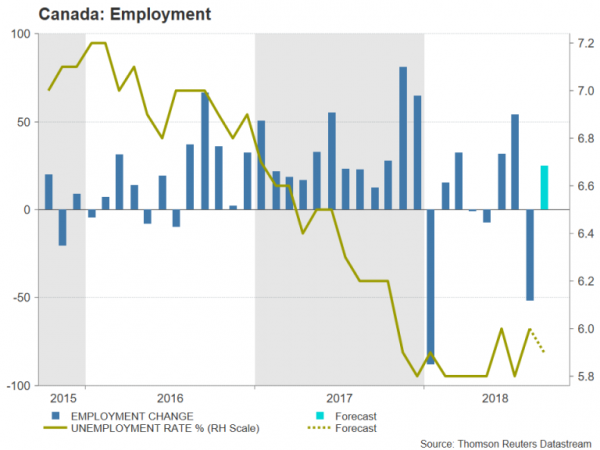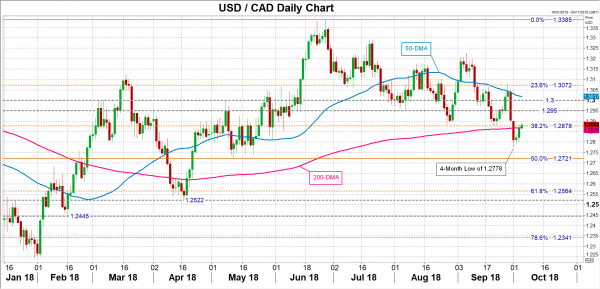Employment numbers out of Canada, due at 12:30 GMT on Friday, will be investors’ next focus after the surprise deal over the weekend to upgrade NAFTA. With trade worries out of the way and an anticipated rebound in jobs growth in September, the Canadian dollar is set to extend its bullish streak, as expectations rise that the Bank of Canada will raise interest rates later this month.
Net change in employment unexpectedly slumped in August, with 51.6k jobs being lost, though the drop was mainly attributed to a sharp slide in part-time jobs. After a strong performance in 2017, jobs growth in Canada has been patchy in 2018, with the unemployment rate flatlining at between 5.8%-6.0%. But the labour market is forecast to have improved in September, with the economy expected to have created 25k jobs. The jobless rate is forecast to ease slightly from 6.0% to 5.9%.
A positive set of figures on Friday would boost market expectations of a rate hike by the Bank of Canada at its October 24 meeting. Those odds, as implied by overnight index swaps, currently stand at 77%, indicating the market is some way off in fully pricing a rate increase. The Canadian dollar therefore could be poised to rally significantly should those odds start to move closer to 100%.
One major hurdle for further BoC rate hikes was cleared at the start of the week with the conclusion of the NAFTA renegotiation. The United States and Canada managed to strike a last-minute deal late on Sunday, hours before the US-imposed deadline of October 1, ending months of uncertainty about the future of NAFTA, which will now be renamed to USMCA (the United States-Mexico-Canada Agreement).
Having soared to a 4-month high of C$1.2778 per US dollar on Monday, the loonie’s next target could be 1.2721, which is the 50% Fibonacci retracement of the upleg from 1.2057 to 1.3385. A break below this level for dollar/loonie would underscore the bearish medium-term structure for the pair, which has been making lower highs and lower lows since July. Below this mark, the 61.8% Fibonacci of 1.2564 should be watched, which is not too far from the April trough of 1.2522. Further down, the February low of 1.2445 is the next key support level.
In the event, however, of a worse-than-expected reading on Friday, the loonie could fall victim to some profit taking, though the losses would likely be limited as weak job figures alone would probably not be enough to prevent the BoC from raising rates given the recent uptick in inflation. Dollar/loonie could initially eye the 38.2% Fibonacci level at 1.2878 if there is an upside reversal. Moving higher, resistance could be met at 1.2950, a recent congested region. A climb above this level would set the path towards the 1.30 handle and bring into range the 23.6% Fibonacci retracement of 1.3072.















